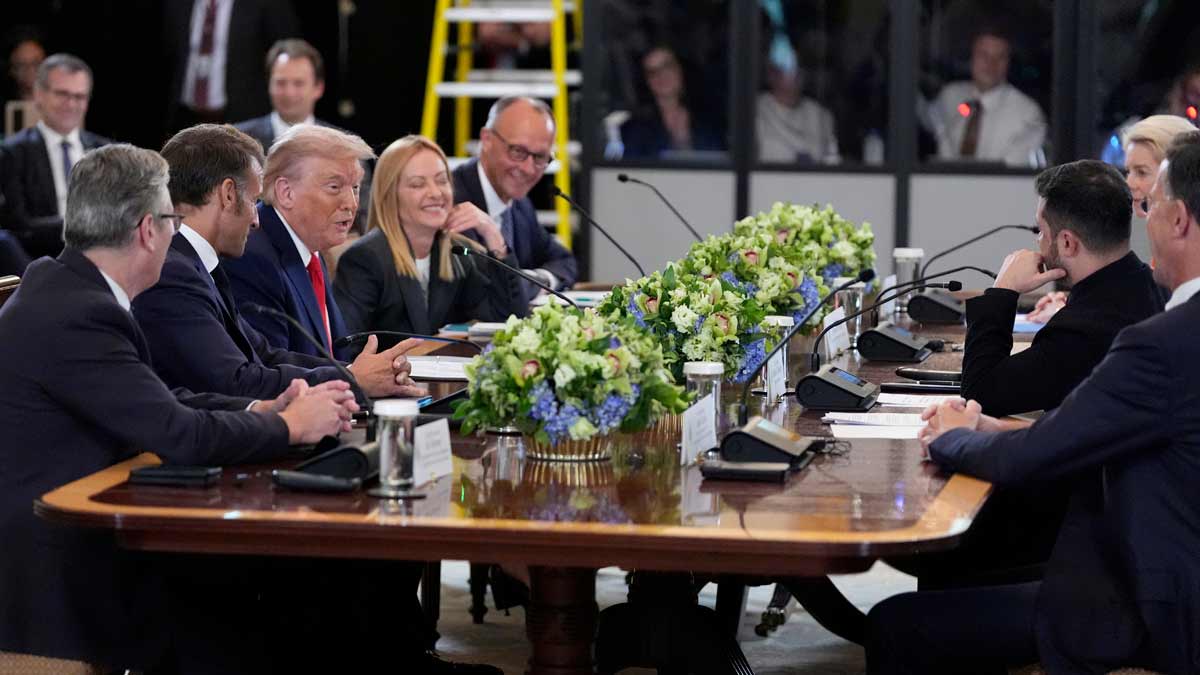Trump pushes for a Putin-Zelenskyy summit, followed by a trilateral involving himself
 President Donald Trump, centre left, speaks during a meeting with Ukrainian President Volodymyr Zelenskyy, center right, and European leaders in the East Room of the White House | AP
President Donald Trump, centre left, speaks during a meeting with Ukrainian President Volodymyr Zelenskyy, center right, and European leaders in the East Room of the White House | AP
President Donald Trump staged an extraordinary day of diplomacy at the White House yesterday, setting in motion preparations for a potential summit between the leaders of Russia and Ukraine that he claims could mark a decisive step toward ending Europe’s bloodiest conflict in decades.
Trump welcomed Ukrainian President Volodymyr Zelenskyy and seven European figures, including French President Emmanuel Macron, German Chancellor Friedrich Merz, British Prime Minister Keir Starmer, Finnish President Alexander Stubb, Italian Prime Minister Giorgia Meloni, NATO Secretary General Mark Rutte and European Commission President Ursula von der Leyen. Diplomats described the atmosphere as unusually urgent, reflecting both a desire to align with Trump’s push for peace and European unease at being left on the sidelines of a process driven from Washington.
Behind the closed doors of the Oval Office, discussions focused on two questions: how to guarantee Ukraine’s long-term security and how to open a credible path to direct negotiations with Moscow. By evening, Trump had telephoned Russian President Vladimir Putin in a bid to secure agreement for a face-to-face meeting with Zelenskyy. If successful, it could redefine the trajectory of a war that has raged since Russia’s full-scale invasion in February 2022.
From the outset, Trump made clear that his primary goal was to engineer a trilateral summit involving himself, Zelenskyy and Putin. He insisted that such a meeting could deliver a breakthrough in negotiations and told reporters it was a matter of “when, not if”. His proposal was to begin with a direct encounter between Putin and Zelenskyy, followed by a three-way session that would include him. The plan was floated after a lengthy phone call with Putin, held privately in the Oval Office without European representatives. Russia has yet to confirm the arrangement, though Putin has indicated openness to the idea.
European leaders urged broader participation. Macron proposed a quadrilateral format that would include at least one European leader, stressing Europe’s wider security interests. Trump appeared reluctant, signalling his determination to maintain a central role.
The issue of security guarantees dominated discussions. Zelenskyy and the Europeans pressed for firm commitments to prevent Russia from regrouping and launching fresh attacks once a settlement is reached. Trump, elected partly on a pledge to keep the United States out of foreign wars, surprised many by refusing to rule out sending American troops to Ukraine as part of a peacekeeping arrangement. He promised “a lot of help” while suggesting Europe would carry the primary burden, with Washington coordinating and potentially contributing forces.
According to Trump, Putin indicated that Russia could accept security guarantees for Ukraine, although the details remained vague. Ukrainian officials are pushing for binding commitments modelled on NATO’s Article 5, which would require approval by the United States Senate. Another option discussed was a vast arms package worth $100 billion, in which Ukraine would purchase American weapons financed by European partners in exchange for US backing.
One of the day’s most striking developments was Trump’s shifting stance on a ceasefire. He had previously declared that he would consider his summit with Putin a failure without one. Yesterday, he argued that a ceasefire was unnecessary and that talks should move directly to a final peace agreement. He told reporters that in the “six deals” he had struck that year, none involved ceasefires. The comments alarmed European leaders. Merz insisted that a ceasefire was vital for credibility and said he could not imagine further meetings without one. Macron echoed his concern. Trump shrugged off their objections, leaving the decision to Zelenskyy and Putin.
Territory remains another thorny issue. Putin has made clear he expects to retain around 20 per cent of Ukrainian land, including Crimea, as the price for peace. Zelenskyy has repeatedly said that the Ukrainian constitution forbids ceding territory. Trump nevertheless floated the idea of territorial exchanges, suggesting that the current line of contact could be the basis for discussion. His remarks appeared to undercut Secretary of State Marco Rubio, who had insisted Ukraine would not be pressured into giving up land. Trump also hinted that Ukraine should abandon its NATO ambitions as part of a settlement.
Despite the difficult topics, the Oval Office meetings were notably warmer than previous encounters. Zelenskyy avoided confrontation, delivering a personal letter from his wife to Melania Trump and repeatedly thanking the US president for his mediation. In a symbolic gesture, he wore a suit instead of his customary military fatigues, joking about the change with Trump. The tone was markedly different from earlier in the year when Trump’s aides, including Vice President JD Vance, had voiced open criticism. This time, they held back, allowing for what Zelenskyy later described as “a very good conversation”.
For Trump, the frenetic diplomacy appears designed to cast him as the man capable of ending Europe’s bloodiest war in generations. His recent private meeting with Putin in Alaska underscored his determination to shape the peace process. Some observers suggest he has an eye on the Nobel Peace Prize. Others warn that he risks ceding control of the narrative to Moscow.
World